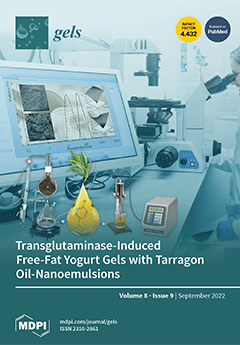Open AccessArticle
Ionogels Derived from Fluorinated Ionic Liquids to Enhance Aqueous Drug Solubility for Local Drug Administration
by
Carolina Hermida-Merino, David Cabaleiro, Carlos Gracia-Fernández, Jesus Valcarcel, José Antonio Vázquez, Noelia Sanz, Martín Pérez-Rodríguez, Maria Arenas-Moreira, Dipanjan Banerjee, Alessandro Longo, Carmen Moya-Lopez, Luis Lugo, Patrice Bourson, Ana B. Pereiro, Georges Salloum-Abou-Jaoude, Iván Bravo, Manuel M. Piñeiro and Daniel Hermida-Merino
Cited by 3 | Viewed by 4029
Abstract
Gelatin is a popular biopolymer for biomedical applications due to its harmless impact with a negligible inflammatory response in the host organism. Gelatin interacts with soluble molecules in aqueous media as ionic counterparts such as ionic liquids (ILs) to be used as cosolvents
[...] Read more.
Gelatin is a popular biopolymer for biomedical applications due to its harmless impact with a negligible inflammatory response in the host organism. Gelatin interacts with soluble molecules in aqueous media as ionic counterparts such as ionic liquids (ILs) to be used as cosolvents to generate the so-called Ionogels. The perfluorinated IL (FIL), 1-ethyl-3-methylpyridinium perfluorobutanesulfonate, has been selected as co-hydrosolvent for fish gelatin due to its low cytotoxicity and hydrophobicity aprotic polar structure to improve the drug aqueous solubility. A series of FIL/water emulsions with different FIL content and their corresponding shark gelatin/FIL Ionogel has been designed to enhance the drug solubility whilst retaining the mechanical structure and their nanostructure was probed by simultaneous SAXS/WAXS, FTIR and Raman spectroscopy, DSC and rheological experiments. Likewise, the FIL assisted the solubility of the antitumoural Doxorubicin whilst retaining the performing mechanical properties of the drug delivery system network for the drug storage as well as the local administration by a syringe. In addition, the different controlled release mechanisms of two different antitumoral such as Doxorubicin and Mithramycin from two different Ionogels formulations were compared to previous gelatin hydrogels which proved the key structure correlation required to attain specific therapeutic dosages.
Full article
►▼
Show Figures






